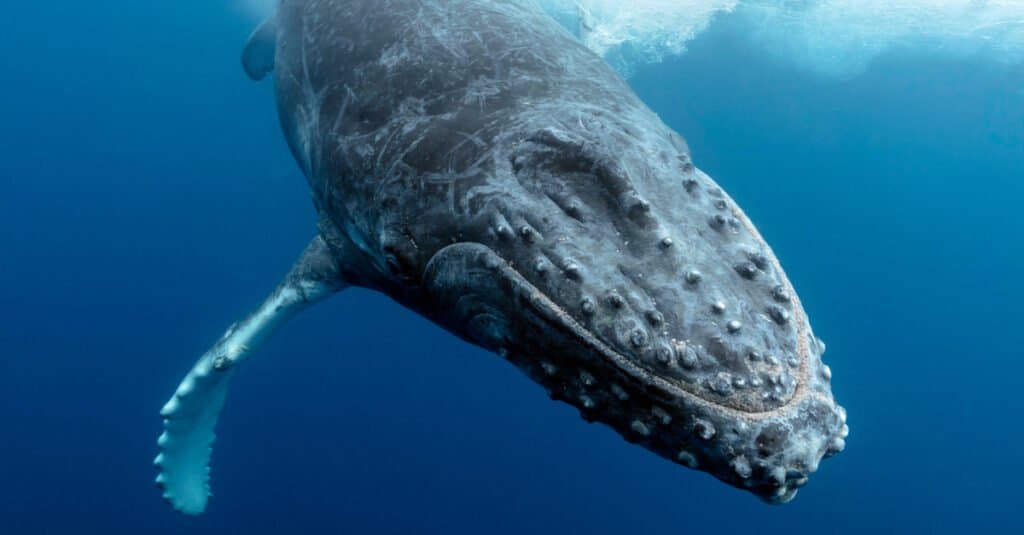Migratory baleen whales, humpbacks can live solitarily or in temporary pods of 2-15 individuals. So, how do humpback whales communicate with each other? To maintain peaceful group cohesion and communicate with individuals over long distances, humpback whales rely primarily on using a range of acoustic signals.
This guide will delve into the types of acoustic communication humpback whales use and what these signals mean.
Read on to learn more.
How Do Humpback Whales Communicate: Acoustic Signals
The primary method of communication for humpback whales (Megaptera novaeangliae) is acoustic signaling. They can produce simple calls or arrange their vocalizations into complex, repeating sequences called whale songs.
To produce these calls and songs, humpback whales make a wide range of primarily low- to mid-frequency vocalizations, including grunts, groans, shrieks, clicking, low-toned guttural roars, moans, and blasts. The songs of humpback whales are typically long with a repetitive structure. In comparison, non-song vocalizations, or calls, are shorter and don’t feature a redundant structure.
Humpback whales lack vocal cords, producing their calls and songs through the larynx. Non-song vocalizations range in frequencies from 9 Hertz to 6,000 Hertz, and most of these calls are produced under 200 Hertz. The songs of humpbacks, however, can range from 24 Hertz (Hz) to 24,000 Hertz.

Humpback whales primarily communicate with each other through vocalizations.
©Tomas Kotouc/Shutterstock.com
Male Humpback Singing
Scientists believe only male humpback whales sing, while all humpbacks can make non-song vocalizations. Previously, whale biologists thought that male humpback whales only sang in breeding areas when searching for a mate. However, research has shown that although much of the singing does occur in breeding grounds, male humpbacks will sing outside the context of courtship in their feeding grounds and during migration. Current theories of why humpbacks sing outside their breeding grounds include practicing, hormonal shifts, and even showing off.
Humpback whale songs comprise units that are the shortest audible sounds. A series of units make up a phrase. A series of words make up a theme, and finally, a series of themes make up the song. One song can last up to 30 minutes and may be repeated for up to 24 hours.
Mind-bogglingly, the lowest frequency components of their songs can travel up to 10,000 miles. This incredible ability allows male humpbacks to send poetic messages to potential mates across oceans. One study found that a whale song in French Polynesia traveled across the Pacific Ocean to Ecuador.

Male humpback whales produce songs defined by patterned, complex, and repeated vocalizations.
©Craig Lambert Photography/Shutterstock.com
Singing in Chorus
Not only do individual male humpbacks produce complex songs that can carry thousands of miles, but they can also sing in choruses. Each population produces different songs in their choir, stringing together sounds in unique variations. Every few years, it’s common for populations to compose entirely new songs. Researchers have also found that populations will share their songs. As parts of their sounds survive across the seas, other populations of male humpbacks are known to pick up these components and create their renditions.
How Do Humpback Whales Communicate: Non-Song Vocalizations
All humpback whales use a range of non-song vocalizations to communicate. Individuals use these calls in a variety of social contexts. This can include during group feeding, between mother and calf, between competing males, maintaining contact across long distances, sounding alarms, and initiating coordinated movements. Scientists also observe solitary humpbacks of both sexes making non-song vocalizations. The purpose of these calls, which don’t travel great distances, is still unknown.

While only males produce songs, all humpback whales use non-song vocalizations to communicate with each other. A mother and calf use a variety of calls as they travel together.
©iStock.com/inusuke
How Do Humpback Whales Communicate: Non-Vocal Acoustic Communication
While most humpback communication relies on song or non-song vocalizations, these amazing marine animals also use other forms of acoustic signaling.
Tail Slapping
Many species of whales slap their tails on the water’s surface, possibly for predation and communication purposes. Known also as lobtailing, humpbacks will slap the water vertically with their tail. The sound produced from the action can travel miles under the water, indicating that communication is quite possibly one of the purposes of this behavior. Whale biologists’ theories on the purpose of whale slapping for communication include expressing irritation or initiating group movement.

Whale biologists believe that tail slapping and its use as a hunting strategy may also serve as a form of communication.
©iStock.com/ANDREYGUDKOV
Flipper Slapping
Humpback whales will also perform flippers or pectoral fin slaps. To do this, they will roll onto their back, lift their flippers out of the water, and slap them down onto the water. Current theories for this behavior as a means of communication include expressing joy, initiating play, or attracting the attention of potential mates.

Flip slapping may be another non-vocal, acoustic communication between humpback whales.
©adwalsh/iStock via Getty Images
The photo featured at the top of this post is © Justin Berken/Shutterstock.com
Thank you for reading! Have some feedback for us? Contact the AZ Animals editorial team.







